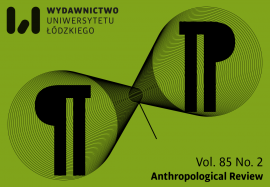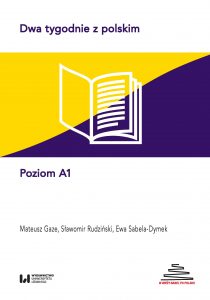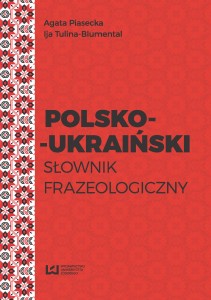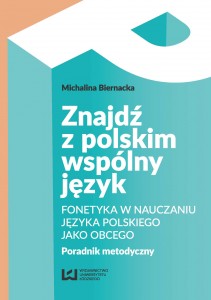Anthropological Review | Vol. 85 No. 2 (2022)
Opublikowano: 28 września 2022

Anthropological Review (dawniej Przegląd Antropologiczny i Przegląd Antropologiczny – Anthropological Review) to oficjalna publikacja Polskiego Towarzystwa Antropologicznego wydawana przez Wydawnictwo Uniwersytetu Łódzkiego. Czasopismo ma długą tradycję publikowania od momentu założenia w 1926 roku przez wybitnego polskiego antropologa fizycznego i lekarza Adama Wrzosa. Czasopismo ukazuje się kwartalnie przy wsparciu finansowym Ministerstwa Nauki i Szkolnictwa Wyższego RP. Od 1997 roku, Anthropological Review publikuje w języku angielskim i jest czasopismem naukowym poświęconym zagadnieniom antropologii fizycznej (m.in. zmienność biologiczna człowieka, wzrost i rozwój człowieka, paleoantropologia, biologia szkieletu, antropologia stomatologiczna) oraz dziedzinom pokrewnym (m.in. psychologia, biologia teoretyczna, demografia). Czasopismo stara się zatem promować interdyscyplinarne spojrzenie na człowieka.
Redaktorem naczelnym czasopisma jest Profesor Sławomir Kozieł (ORCID).
W numerze 85/2:
Darina Falbová, Lenka Vorobeľová, Veronika Candráková Čerňanová, Radoslav Beňuš, Daniela Siváková
Leu432Val (rs1056836) polymorphism of the CYP1B1 gene was examined in relationship with lipid profile in hypertensive Slovak women according to their menopausal status. The entire study sample comprised 255 women suffering from hypertension aged from 39 to 65 years who were recruited from different localities in the western, southern, and middle parts of Slovakia. The participants provided a saliva or blood sample for DNA genotyping and a blood sample for biochemical analysis. The Leu432Val genotypes demonstrated statistically significant associations with all monitored atherogenic indices – total cholesterol-to-HDL-Cholesterol (AI1), Non-HDL-Cholesterol (AI2), LDL-Cholesterol-to-HDL-Cholesterol (AI3), and the logarithm of the ratio of plasma concentration of triglycerides to HDL-cholesterol (AIP log) in hypertensive pre/perimenopausal women. The mean values were significantly lower in women carrying the Val/Val genotype. In early postmenopausal hypertensive women the Leu432Val genotypes were statistically significant and associated with LDL-cholesterol (LDL-C) and AI2. The mean values of LDL-C and AI2 were significantly lower in women carrying the Leu/Leu genotype. In conclusion, the Leu432Val polymorphism may be associated with the atherogenic indices and LDL-C in hypertensive women.
Sacral Spina Bifida Occulta: A Frequency Analysis of Secular Change
Ella R Kelty, Maciej Henneberg
Substantial relaxation of natural selection beginning around 1900 changed the mutation/selection balance of modern genetic material, producing an increase in variable anatomical structures. While multiple structures have been affected, the temporal increase in variations of the sacrum, specifically, ‘Sacral Spina Bifida Occulta,’ have been reliably demonstrated on a localised scale. Calculation of largescale frequency has been hindered by the localised nature of these publications, the morphological variability of this variation, and potential pathological associations, which have produced divergent classifications, and conflicting reported rates of occurrence. A systematic review of the reported literature was conducted to provide an objective analysis of Sacral Spina Bifida Occulta frequency from 2500 BCE to the present. This review was designed to compensate for observed inconsistencies in reporting and to ascertain, for the first time, the temporal trajectory of this secular trend. A systematic review of Sacral Spina Bifida Occulta literature was conducted through the strict use of clinical meta-analysis criteria. Publications were retrieved from four databases: PubMed, Embase, the Adelaide University Library database, and Google Scholar. Data were separated into three historical groups, (1 = <1900, 2 = 1900 to 1980 and 3 = >1980), and frequency outcomes compared, to determine temporal rates of occurrence.
A total of 39/409 publications were included in the final analysis, representing data for 16,167 sacra, spanning a period of 4,500 years. Statistically significant results were obtained, with total open S1 frequency increasing from 2.34%, (79 to 1900CE), to 4.80%, (1900 to 1980CE) and to 5.43% (>1980CE). These increases were significant at p<0.0001, with Chi-squared analysis. A clear secular increase in the global frequency of Sacral Spina Bifida Occulta has been demonstrated from 1900 to the present. This research provides a novel and adaptable framework for the future assessment of variation distribution, with important implications for the fields of biological anthropology and bioarchaeology.
Jesús Herrerín, Enrique Dorado, Francesco M. Galassi, Elena Varotto, Rosa Dinarès Solà
The aim of this study is to show the cranial alterations that Klippel-Feil syndrome produced in a case older than 200 years. Few paleopathological case studies diagnosed as Klippel-Feil Syndrome are focused on cranial abnormalities. A skull numbered 778, belonging to the Federico Olóriz Aguilera collection (Spain, 19th century AD), Universidad Complutense de Madrid, belonging to a young man born in a town in the North of Spain, was investigated. This cranium was visually inspected, hence macroscopically and paleoradiologically studied, using the images obtained through conventional radiology and CT scan imaging. In addition to the vertebral fusion between the atlas (C1) and the axis (C2), atlanto-occipital fusion, basilar impression, obliteration of the sagittal suture, enlarged parietal foramina and significant craniofacial asymmetry affecting maxillary bones, sphenoid, orbits, nasal bones and both palatines were observed. Morphological findings make it possible to diagnose a Klippel-Feil syndrome, possibly type-II, although the lack of the rest of the spinal column renders it impossible to verify other spinal anomalies. As a limitation, only the cranium and two cervical vertebrae were preserved, hence the possible involvement of the rest of the skeleton cannot be verified.
Moral foundations tracked over 200 years of lexicographic data, and their predictors
Michael A. Woodley of Menie, Aurelio José Figueredo, Mateo Peñaherrera-Aguirre, JohnMichael Jurgenssen, Matthew A. Sarraf
The prediction that reduction of negative selection decreases group-level competitiveness, as reflected in increased individual-focused and diminished group-focused moral foundations, is tested. To measure this hypothesized shift in moral foundations, we conduct a culturomic analysis of the utilization frequencies of items sourced from the moral foundations item pool, tracked among Britannic populations from 1800 to 1999 using Google Ngram Viewer. The resultant higher-order factor, which tracks increasing individualizing values and decreasing binding values, is termed Asabiyyah (capturing social cohesion and collective purpose). Two predictors of this factor are examined: change in the strength of intergroup competition and change in levels of indicators of developmental instability. Both the strength of intergroup competition and levels of developmental instability associate with Asabiyyah. Rising developmental instability mediates the impact of inter-group competition, indicating that reduced between-group competition might have relaxed negative selection against mutations, which might reduce Asabiyyah via their effects on inter-genomic transactions. These results must be interpreted carefully, given the clear real-world evidence that explicit commitment to group-oriented values often features in harmful and maladaptive social and political ideologies of an extreme character.
Hubert Lepionka, Angelika Słodka, Olga Dec
The paper presents preliminary results of an anthropological analysis of a previously unknown post-medieval stelae cemetery in the village of Nowy Dwór in Podlaskie Voivodeship, Poland. The main aim of the study was to identify the site itself, and to create the probable biological profile of the local population. The research confirmed the existence of a post-medieval necropolis in which remains of at least 181 individuals were unearthed, with 111 individuals discovered in 88 intact graves and their closest proximity. Few individuals were equipped with what can be interpreted as “obol of the dead”, and at least three burials could be classified as deviant. Biological analysis showed that 33% of analysed individuals regardless of age bore infection-related lesions and post inflammatory pathologies. Constructed mortality tables also correspond more with tables for medieval rather than post-medieval populations. As a conclusion, collected evidence and results of analysis seem to verify the historical accounts mentioning several plague outbreaks in the region, occurring from the 16th to 18th centuries. Individual findings such as “obol of the dead”, as well as the “deviant grave”, likely belonging to a whisperer (witch), can also provide useful to further research on local traditions and beliefs.
Agata Bisiecka, Krzysztof Brysławski
Introduction: According to criminal codes of most Western countries, possessing, producing and disseminating of fictional paedopornography is a crime. In light of these laws, the shotacon/lolicon (popular and widely available Japanese animations or comic books showing minors in a sexual context) seems to deserve special mention. There have been several convictions for violations of these laws, however, the methodology of a depicted person’s age estimation is still unestablished.
The aim of this study was to assess the suitability of anthropometrical prediction of age to the analysis of characters animated in the Japanese style.
Material and methods: The metric (distance between facial landmarks) and non-metric (type of chin shape) features of 173 animated characters’ faces were obtained. Material was collected from 90 most popular Japanese anime series. Measurements were conducted in ImageJ software. The correlations of age and standardized measurements: en-ex, en-en, eye height, pu-prn, pu-sto, pu-gn were examined. The chin shape was described by three independent ‘judges’.
Results and conclusions: Correlations for pu-prn, pu-sto, pu-gn and eye height in females and in all males were statistically significant. Age prediction was made using linear regression equations. Good prediction (± 1 year) was obtained for 44% males and 17% females. Prediction within the acceptable range (± 2 years) was achieved for 23% of males and 18% of females. In total, the prediction with an error of no more than ± 2 years was obtained for 67% of males and 35% from females, which is comparable to the results obtained in the study of real children. Moreover, triangular or rounded chin shape was significantly more frequent in boys aged 10–12 years, and square in older boys 16–18 years. Current research provides a basis for developing a methodology for assessing the age of animated characters. There is a need for further research in this area.
Agnieszka Tomaszewska, Julia Anna Lubońska
The 2D:4D digit ratio has been established as a biomarker of the level of exposure to prenatal sex hormones’ balancebetween prenatal testosterone (PT) and estrogenne levels. Higher 2D:4D indicates lower PT exposure and vice versa. Data suggests that PT exposure is linked to a risk-taking attitude and physical aggressiveness, both of which are requirements in contact sport. A possible correlation between 2D:4D and human body mass index has also been identified. The aim of the study was to examine the relation between 2D:4D ratio and choice of sport. It was assumed that female soccer players who choose a contact sport would have a lower 2D:4D ratio (thus experiencing higher exposure to PT) than female volleyball players (selecting non-contact sport). The analysis was also aimed at identifying whether a correlation between prenatal testosterone level and BMI exists. The participant sample consisted of 103 women – 36 volleyball players, 33 soccer players and a control group (N=34). Measurements were collected in 2019–2020. The results suggest that 2D:4D was significantly different in women practicing various sports (contact and non-contact sports). Women engaged in contact sports had lower 2D:4D than women engaged in non-contact sports, and vice versa (p<0.05). 2D:4D correlated positively with BMI and body weight – the higher the 2D:4D ratio, the higher the BMI and body weight (and vice versa) (p<0.05). Low 2D:4D (high PT exposure) may predict the choice of more risky, aggressive contact sports, and vice versa. High 2D:4D may predict a higher BMI and body weight, and vice versa.
Papiya Roy, Suman Chakrabarty, Diptendu Chatterjee, Premananda Bharati
Overweight and obesity in adolescent girls are considered a leading global public health issues in recent times. There is a need to evaluate the potential socioeconomic and behavioural factors behind adolescents’ overweight and obesity in different environmental settings. The present study aims to understand the prevalence of overweight and obesity among urban adolescent school girls and to determine the association between selected socioeconomic and behavioural factors and overweight/obesity. This is a cross-sectional study using a multistage stratified cluster sampling with a sample size of 1041 adolescent girls aged 10 to 18 years from schools of Kolkata, India. Overall prevalence of overweight and obesity were 18.9% and 23.7%, respectively. The prevalence of overweight and obesity was higher among those adolescent girls whose parents had completed higher education (49.5%) and had higher monthly per capita household expenditure (48.4%). Stepwise binary logistic regression analysis confirmed that the probability of being overweight/ obese tended to be in adolescents who slept less than 7 hours per day (p<0.001). Overweight /obesity was also higher among those children whose fathers were fatty (p=0.002), taken medicines three months before the survey (p=0.008), and watched television and mobile phones for more than 1 hour a day (p=0.039). Rapid change in modern lifestyles is seemingly decreasing sleep duration in adolescents with subsequent negative impact on their health.
Francesc Ribot Trafí, Mario García Bartual, Qian Wang
Zapraszamy do lektury!
Komentarze
Ten post dostępny jest także w języku: angielski





